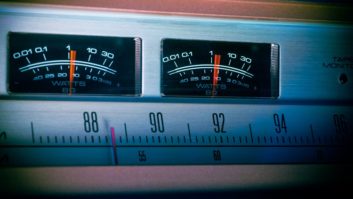We continue to receive letters to the editor about the idea of using mono instead of stereo in certain FM broadcast situations in response to original commentaries by David Bialik and Gary Keener. Here are four more. Comment on this or any article. Email [email protected].
Responding to the Stereo Light
I just want to add my own experience on this subject of mono vs. stereo on FM.
This goes back 40 years, so I understand the relevance may be problematic due to the differences in today’s receivers.
Around 1980 I was chief engineer at WDHA(FM) in Dover, N.J. The audio went up to the transmitter on 15 kc phone lines, and we had an Orban 8000 stereo generator.
Whenever we needed to do something that required us to go mono, usually involving the phone lines, I would put the stereo generator in the mono left or right mode, depending on what we were working on, thus turning the pilot off (and turning the stereo light off on receivers). The board would also be put in mono.
We would always get a few calls asking why we were not in stereo, which would upset the general manager. So I started paralleling whichever side we were not working on into the stereo generator, therefore transmitting in mono while the stereo light on receivers stayed on. Never got a call when doing this.
I’m not trying to take one side or the other, just reporting my real-world experience and letting the reader draw their own conclusions. Mine was that listeners depended much more on the stereo light to determine whether they were listening in stereo than anything else.
– Alan Parnau
Fred Baumgartner: “FM Stereo Should Be Rare and Vibrant”
I didn’t comment earlier on the FM mode conversation because I assumed, inaccurately, that I’d be repetitive.
If I am airing talk or background music, or using compression (and I sure have) to reach as many radios as I can, then it’s mono. If high-quality, front-of-attention music is my thing, then it’s unsoiled stereo. If I alternate between the two, as many public/community broadcasters do, then the mode should change with the programming. (I sure did that, too — it takes effort, but it’s not hard.)
With today’s radios, the pilot light is either gone or ignored, there’s nothing to be gained there anymore. You can only have one No. 1 priority. When I really want to listen — feel the bass, strain to hear the noise floor, have speakers on either side of the desk, wear headphones, look up the playlist when excited — I’ll use the switchable FM antennas (two for two markets) distributed to several receivers, or even my one HD receiver (won at an NAB ham reception) rebroadcast on my flea-power house transmitter.
Outdoor FM antennas might be only for us fools, but anyone who’s into curated high-fidelity music will at least move a radio around to get best reception … or stream or buy an HD Radio. For me that kind of music comes from “The Colorado Sound 105.5,” 60 miles away with a co-channel 30 miles off (hence the directional antennas). Or stream WXPN Philadelphia. With all that, 105.5 is cleanest, requires far less futzing and earns most of my time and financial support.
FM stereo should be rare and vibrant. It might be heresy, but the sweet spot for multidimensional sound is big-screen video in a suitable space. As for talk mono, please compress! You’ll reach more folks, and it’ll be much easier to hear. For talk, dynamic range just produces fatigue.
– Fred Baumgartner, Elizabeth, Colo.
John Schmidt: “The Worst of Both Worlds”
There have been a number of interesting comments in this matter. Personally, I suspect, based on absolutely no data, that, depending on the format, the loss of listeners due to the added noise in stereo broadcasts in fringe areas is less than the loss of listeners due to broadcasting in mono — either due to receivers that won’t select mono signals when scanning (or worse will either mute the audio if the pilot disappears or scan to a different station if the pilot disappears), or due to music listeners choosing the competition because a station is broadcasting stereo music in mono.
But my important comment is in regard to suggestions that stations broadcast in mono but with the 19 kHz pilot present.
It is worth noting first that unless the pilot is generated as a part of a stereo generator that complies with FCC rule 73.322, and at least initially had performance measurements showing that it complied with that rule, the station would be in violation of the commission’s rules and potentially subject to a notice of violation.
The commission dropped its informal “no pilot if the mono material is more than five minutes long” policy in June 1973, leaving it up to licensees, in part because of the issues I mentioned in the first paragraph, but did not discuss stations broadcasting only in mono full-time, however with a stereo pilot. I rather suspect they might frown on operating full-time in that mode.
Second, however, the commenters proposing that mode of operation may not be aware that if the pilot is on, a receiver in stereo mode will be decoding the full bandwidth of the stereo system (and its noise), even if the audio is mono. The broadcaster is losing the advantage of the better signal-to-noise ratio of a mono signal.
The worst of both worlds. They gave up the potentially greater enjoyment of the stereo program material but have kept the increased noise floor that the stereo broadcasting system imposes.
John Schmidt, P.E., E.E., (Mostly) retired broadcast engineer
Ted Schober: Leverage the Mono Switch for Added Interactivity
An interesting sidelight to the recent FM mono discussions is the potential for ancillary data on FM stations when the stereo pilot is shut off.
The extremely limited data rate for RBDS could be greatly augmented to provide things like album art, artwork to accompany commercials and news stories, etc. if the station took advantage of the FM Multiplex Transmission and Visual Transmissions contemplated in sections 73.310(a) and 73.310(c) when the pilot is switched off.
This scheme is meaningless and transparent to old receivers, but most current receiver chips have sufficient processing power to implement this with a software change. A standard would need to be established that implemented this type of operation.
An advantage would be the dynamic switching of the pilot when there is no stereo content, which will provide the advantages of greater multipath immunity and a greatly enhanced RBDS function.
Adding OFDM carriers in the L–R multiplex composite bandwidth between 23 and 53 kHz would allow a data rate of between 45 and 108 kbps, fully adequate for semi real-time transmission of small-format (4.5 inch) photos and artwork, along with alternate audio to a dashboard or front panel of a radio.
Or alternate audio content could substitute for main-channel audio with detailed local weather, commercial or traffic information. This could be achieved by GPS geofencing or by preferences communicated by the listener.
An example of this would be individual traffic reports for each side of a river or mountain or for different quadrants of a city. These downloaded reports would replace the general report on the main channel for suitably equipped vehicles or portable radios. Likewise, specific commercials might be played only when near the client.
It may be necessary to decrease the data rate and supply two copies of the ODFM carriers, one above and one below 38 kHz outphased from each other to assure that receivers that do not promptly or completely disable stereo detection don’t pick up noise in the audio from the OFDM carriers. This would reduce the data rate of a given encoding scheme but permit a higher number of modulation states, i.e. modulation of 64 or 128 QAM or a less robust FEC scheme. The system would be cheap to implement both at the transmitter and in existing receiver chip hardware. It may be possible to use this scheme to reduce peak FM deviation from the ODFM signal by synchronizing the data with the 57 kHz RBDS subcarrier.
I think, for example, decoding this data could be done in the existing Skyworks receiver chips with a mere patch. To take full advantage of it would require some storage, audio decoder and display software in the radio microprocessors, along with GPS data, but it would not necessarily add much to the radio cost (unless some proprietary system is adopted).
Radio has the opportunity to leverage the “mono switch” to added, interactive functionality when the main channel source material is monophonic.
– Ted Schober, Radiotechniques Engineering
[Check Out More Letters at Radio World’s Reader’s Forum Section]











